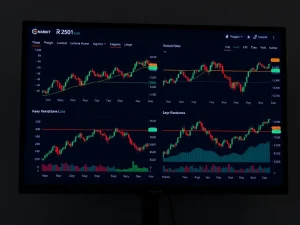REX-Osprey Unleashes Crypto ETFs Amidst Crucial SEC Delays

The cryptocurrency investment landscape experiences a significant shift this week. New **Crypto ETFs** from REX and Osprey are poised for launch. This development marks a pivotal moment for digital asset accessibility in traditional finance. Furthermore, it highlights the complex regulatory environment governing these innovative products.
REX-Osprey Funds Secure Timely SEC Approval
REX and Osprey are preparing to debut several new cryptocurrency exchange-traded funds (ETFs) this Friday. These products have successfully navigated the U.S. Securities and Exchange Commission’s (SEC) 75-day review period. Consequently, they are now cleared for public trading. Bloomberg Intelligence analyst Eric Balchunas confirmed this imminent launch. He stated, “Post-effective means that it’s going to launch, basically,” emphasizing the finality of the regulatory clearance. This **SEC approval** is a major milestone for the issuers and the broader crypto market.
The lineup of these anticipated funds includes a diverse range of digital assets. Investors will soon have access to:
- The REX-Osprey Bonk ETF
- A Trump ETF
- A Bitcoin ETF
- An XRP ETF
- A Doge ETF
Notably, the Doge ETF was initially expected to launch earlier. Its timing depends on its specific structure under the Investment Company Act of 1940. This regulatory framework offers a distinct path to market compared to other filings.
Understanding the 1940 Act Advantage for REX Osprey
The success of the **REX Osprey** funds largely stems from their structure. These ETFs are organized under the Investment Company Act of 1940, often referred to as the ’40 Act. This framework provides a simpler, more direct route to market for certain types of investment products. Unlike products filed under the Securities Act of 1933, which governed the approval of spot Bitcoin (BTC) ETFs last year, ’40 Act funds face fewer immediate hurdles.
Eric Balchunas explained the key difference: “This is a ‘40 Act, which doesn’t directly invest fully in spot.” He further clarified, “So long as the SEC doesn’t say anything, you can let it launch 75 days after filing.” This means the funds can proceed unless the SEC explicitly raises an objection. Most U.S. ETFs operate under the ’40 Act. They function as open-end investment companies, holding various securities, including futures-based funds. In contrast, ’33 Act ETFs typically back physically held commodities, such as gold or spot Bitcoin.
This regulatory nuance has allowed REX and Osprey to push forward with their offerings. Their strategy capitalized on a different legal pathway. Thus, they circumvented some of the more rigorous review processes seen with spot commodity-backed products. This approach demonstrates a growing sophistication in how firms navigate the U.S. regulatory landscape for digital assets.
SEC Delays Decisions on Key Altcoin ETFs
While REX-Osprey funds prepare for launch, the SEC has postponed rulings on several other prominent **Altcoin ETFs**. Major financial institutions like Franklin Templeton, BlackRock, and Fidelity await decisions on their applications. The regulatory body published notices on Wednesday, indicating a need for additional time. Specifically, these delays concern proposals that include allowing staking for Ether (ETH) within the funds. Furthermore, the agency deferred rulings on applications for XRP (XRP) and Solana (SOL) ETFs. These postponements reflect ongoing scrutiny from regulators.
Earlier in the week, the SEC also pushed back decisions on Bitwise’s proposed Dogecoin ETF and Grayscale’s Hedera ETF. New deadlines are now set for November 12. These consistent delays suggest the SEC is taking a cautious approach. They are thoroughly evaluating the complexities of these newer crypto products. This contrasts sharply with the smoother path taken by the REX-Osprey funds.
The Ether ETF Landscape and Staking Considerations
The ongoing delays for the **Ether ETF** applications are particularly noteworthy. Many proposals seek to incorporate staking features for ETH. This allows funds to generate additional yield from holding the asset. However, the regulatory status of staking remains a point of contention for the SEC. Although the agency clarified in May that certain liquid staking activities fall outside securities laws, it maintains a cautious stance on these integrated ETF proposals. The SEC also concluded that proof-of-stake blockchains, by themselves, do not constitute securities. Nevertheless, integrating staking into an ETF product introduces new layers of complexity for regulators to assess. This careful review aims to protect investors while also ensuring market integrity. The outcome of these decisions will significantly influence future crypto product development.
Future Outlook: Navigating Crypto ETF Approvals
The contrasting outcomes for these **Crypto ETFs** highlight the evolving regulatory environment. On one hand, REX and Osprey demonstrate that a clear path to market exists under the ’40 Act for certain crypto-linked products. This offers a blueprint for other issuers. On the other hand, the numerous delays for spot **Altcoin ETFs**, especially those involving staking, signal continued caution from the SEC. Bloomberg ETF analyst James Seyffart reports 92 crypto exchange-traded products are currently in the U.S. pipeline. This indicates robust industry interest. However, each product faces unique regulatory challenges.
Investors and issuers alike must closely monitor these developments. The SEC’s decisions will shape the accessibility and structure of crypto investments. Regulatory clarity remains a crucial factor for broader institutional adoption. As the market matures, understanding these nuanced approvals and delays becomes essential for strategic planning. The journey towards widespread crypto integration into traditional finance continues, marked by both breakthroughs and regulatory hurdles.









